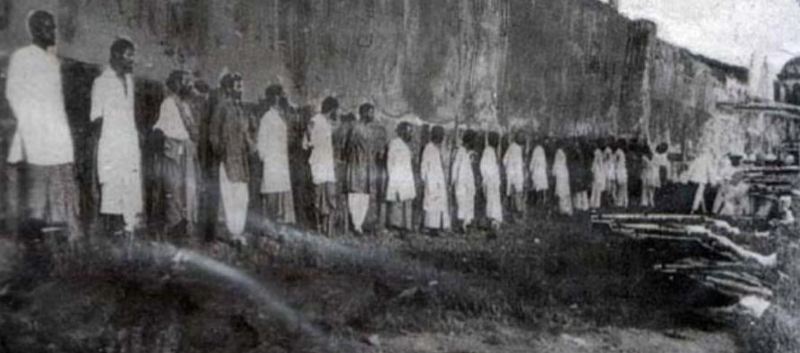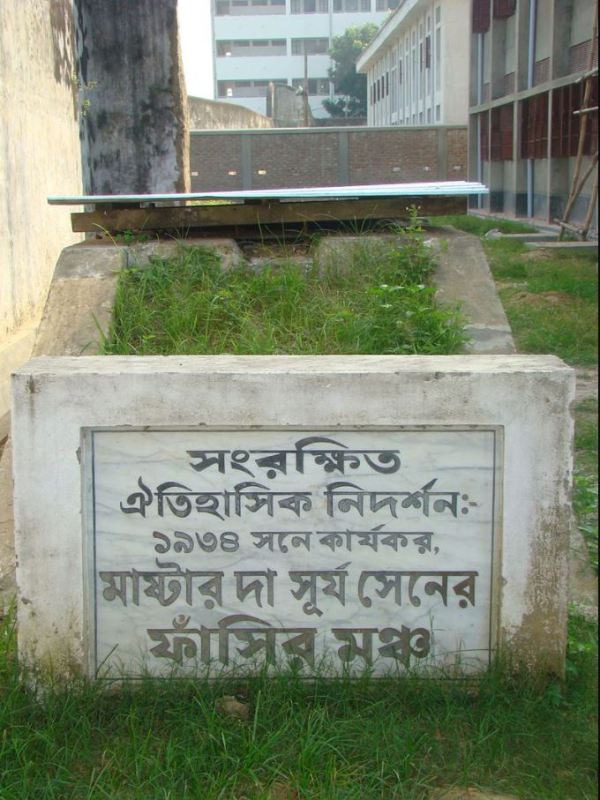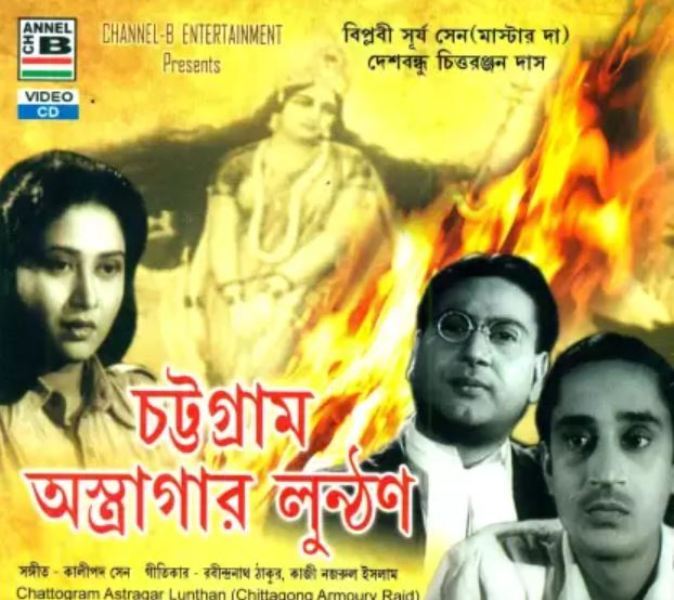Surya Sen Age, Death, Wife, Family, Biography & More
| Bio/Wiki | |
|---|---|
| Full name | Surya Kumar Sen [1]Byjus |
| Other name | Surjya Sen [2]News Click |
| Nickname | Kalu [3]Banglapedia |
| Profession(s) | Indian Freedom Fighter and Politician |
| Famous for | Being the mastermind of the Chittagong Armoury Raid in 1930 and the founder of the revolutionary organisation named Indian Republican Army (IRA) |
| Physical Stats & More | |
| Eye Colour | Black |
| Hair Colour | Black |
| Personal Life | |
| Date of Birth | 22 March 1894 (Thursday) |
| Birthplace | Noapara village, thana Raojan, Chittagong (Now in Bangladesh) |
| Date of Death | 12 January 1934 |
| Place of Death | Chittagong, Bengal Presidency (Now in Bangladesh) |
| Age (at the time of death) | 39 Years |
| Death Cause | Execution by hanging [4]India Today |
| Zodiac sign | Aries |
| Nationality | British Indian |
| Hometown | Noapara village, thana Raojan, Chittagong |
| School(s) | • Dayamoy Primary School • Noapara Higher English school |
| College/University | Berhampore College (now Krishnath College) at Murshidabad |
| Educational Qualification | Bachelors in Arts from Berhampore College (now Krishnath College) at Murshidabad [5]Banglapedia |
| Caste | Baidya family [6]Abhipedia |
| Relationships & More | |
| Marital Status (at the time of death) | Married |
| Affairs/Girlfriends | Not Known |
| Marriage Year | 1919 |
| Family | |
| Wife | Poshpo Kontola Dutta |
| Parents | Father- Rajmoni Sen (Teacher) Mother- Shila Bala Devi |
| Siblings | He had five siblings. |
Some Lesser Known Facts About Surya Sen
- Surya Sen was a Bengali Indian freedom fighter who attempted the Chittagong armoury raid on 18 April 1930 against British Raj in Bengal and the Indian subcontinent. During India’s struggle for independence, in 1918, Surya Sen served as the president of the Indian National Congress of the Chittagong city.
- The parents of Surya Sen died at an early age, therefore, Surya and his siblings were brought up by their uncle ‘Gouromoni.’
- In 1916, Surya Sen got inspired to join the Indian freedom movement through one of his teachers when he was studying bachelor in arts degree from Berhampore College (now Krishnath College) in Murshidabad, West Bengal. Soon, this inspiration led him to join the ‘Anushilan Samity’ revolutionary organisation. In 1918, he joined a National school at Nandan Kanan in Chittagong and started teaching Mathematics. He was a great teacher and was popular with the name Master Da at school. Later, he left his teaching job at the school that he joined after completing his higher education and joined as the president of the Indian National Congress in 1918.
- The Non-cooperation movement started by Mahatma Gandhi was actively joined by Surya Sen. While leading the anti-British rallies, he was arrested by British police who imprisoned him for two years from 1926 to 1928. The phrase that Surya Sen fond to chant while participating in the freedom fighting activities was,
Humanism is a special virtue of the revolutionary.”
- Surya Sen began participating the anti-British activities in Chittagong soon after his release from jail in 1918. Surya Sen, along with his comrades Nirmal Sen and Ambika Chakraborty, formed an organisation titled Indian Republican Army (IRA) in 1930 where several revolutionaries joined them in this uprising movement. In the same year, on 18 April, the members of this organisation plotted a raid on the British police armoury forces at Chittagong under the leadership of Surya Sen. In this plan, they divided themselves into five groups that aimed to seize the armoury. To execute the plan, the communication systems of the whole Chittagong city such as telephone, telegraph, and railway were dismantled by them. The dismantling isolated the Britishers from the happenings in the city. After the execution of the plan, the rebels robbed the arms but failed to capture the ammunition. Before escaping the crime scene, the revolutionaries hoisted the Indian flag at the spot. Soon, the raids conducted by the British government lead to the arrest of several revolutionaries at Jalalabad Hills only a few days after the Chittagong armoury raid.
During the arrest, a severe clash between the police troops and revolutionaries led to the death of 12 revolutionaries and 80 police personnel. Several missionaries managed to escape the scene and Surya Sen was one of them. After the escape, Surya Sen and his group members divided themselves into small groups and hide in the nearby villages where they continue to rob the government treasury and public properties.
- The young revolutionaries of the Chittagong armoury raid were recruited by Surya Sen in 1930. Ananta Singh, Ganesh Ghosh, and Lokenath Bal were the prominent revolutionaries who joined Surya Sen in his movement to fight against the British Raj in India.
- After the Chittagong armoury raid, Surya Sen and his companions were declared absconders by the British government. During this time, Surya Sen kept hiding his identity and worked as a workman, a farmer, a priest, a house worker for some time. He also managed to hide at his friend’s place; but, a relative of Surya Sen named Netra Sen who lived near to his friend’s house leaked the information about his whereabouts to the British police. The police arrested him in February 1933 soon after getting the information about Surya Sen. Later, Netra Sen was beheaded in a fit of rage with a sharp knife by the revolutionary companion of Surya Sen. The wife of Netra Sen did not reveal the name of the revolutionary who murdered Netra Sen as she was the supporter of Surya Sen.
- The British police captured Surya Sen on 16 February 1933. He was ruthlessly tortured by the Britishers before being executed. His teeth were hammered and his nails were plucked by the British jailer so that he could not chant ‘Vande Mataram.’ His joints, limbs, and bones were beaten harshly. He was executed by hanging on 12 January 1934. His group members were soon captured by the Britishers and were awarded life imprisonment. Surya Sen wrote a letter to one of his close friends before being hanged in 1933. The letter read as,
Death is knocking at my door. My mind is flying away towards eternity. At such a pleasant, at such a grave, at such a solemn moment, what shall I leave behind you? Only one thing, that is my dream, a golden dream – the dream of free India. Never forget the date, 18th of April, 1930, the day of the eastern Rebellion in Chittagong. Write in red letters in the core of your hearts the names of the patriots who have sacrificed their lives at the altar of India’s freedom.”
- Surya Sen was hanged by the Britishers at Chattogram, Bangladesh in 1933. The place where he was hanged was nominated as a historical monument for the general public by the Bangladesh government.
- A Metro Railway Station in Kolkata named ‘Masterda Surjo Sen Metro Station’ was inaugurated in memory of Surya Sen by the Indian government for his contribution to the struggle for independence.
- The independence movement started by Surya Sen named Indian Republican Army (IRA) vanished soon after his hanging. This movement was influenced by the Easter Rising in Ireland of 1916.
- Surya Sen and his companions allocated two pamphlets to the general public during the arms raids on 18 April 1930. ‘Breaking the laws of treason’ was the first pamphlet distributed by the revolutionaries that signalled the independence of the Chittagong after the Civil Disobedience Movement led by Mahatma Gandhi, and the other pamphlet was an invitation to the young people of India to participate in the struggle for independence.
- The Indian history book titled ‘India’s Struggle for Independence 1857-1947’ was written by famous Indian historian Bipan Chandra. In this book, Bipan Chandra stated an incident related to Surya Sen. He narrated,
In all, sixty- five were involved in the raid, which was undertaken in the name of the Indian Republican Army, Chittagong Branch. All the revolutionary groups gathered outside the Police Armoury where Surya Sen, dressed in an immaculate white khadi dhoti and a long coat and stiffly ironed Gandhi cap, took a military salute, hoisted the National Flag among shouts of ‘Bande Mataram’ and ‘Inquilab Zindabad, and proclaimed a Provisional Revolutionary Government.”
Bipan Chandra described the unpretentious, soft-spoken and transparently sincere nature of Surya Sen. He wrote,
Surya Sen, a brilliant and inspiring organizer, was an unpretentious, soft-spoken and transparently sincere person. Possessed of immense personal courage, he was deeply humane in his approach. He was fond of saying: ‘Humanism is a special virtue of a revolutionary.”
- Surya Sen began a physical fitness centre in 1928 to train his companion revolutionaries at Chittagong. He focussed on improving the physical and psychological ability of the missionaries. Swimming, rowing boats, climbing trees, playing sticks, throwing knives, boxing were the activities that were instructed by Surya Sen to his revolutionaries. [7]Banglapedia
- The arms raid was decided to be executed on the Good Friday holiday by Surya Sen and his companions on 18 April 1930. On that day all the British troops and officials were at home. At the end of the raid, the revolutionaries got successful in capturing the European club’s headquarters.
- A wanted poster of Surya Sen along with a cash amount of 10,000 takas was disseminated by the British government and the Inspector General of Police Division of Chittagong in 1932 immediately after the arms raid at Chittagong.
- A film titled ‘Chattagram Astragar Lunthan’ was picturised in 1949 on the revolutionary activities of Surya Sen and his group.
- In 1978, the government of India and Bangladesh issued a postage stamp of 25 paise with his picture and name affixed on it to honour the 1930 Chittagong raid.
- A picture was directed by Indian director Ashutosh Gowarikar in 2010 that portrayed the life struggles of Surya Sen against the British Raj. ‘Khelein Hum Jee Jaan Sey’ was the name of the movie in which Indian actor Abhishek Bachchan played the lead character.
- Another picture named ‘Chittagong’ was released in 2012 that was based on the Chittagong armoury raid of 1930, and the lead character of the movie was portrayed by Indian actor Manoj Bajpayee.
- A residential hall named ‘Masterda Surya Sen Hall’ was named after Surya Sen at the University of Chittagong to recognise his contribution to the independence of India.
References/Sources:





















